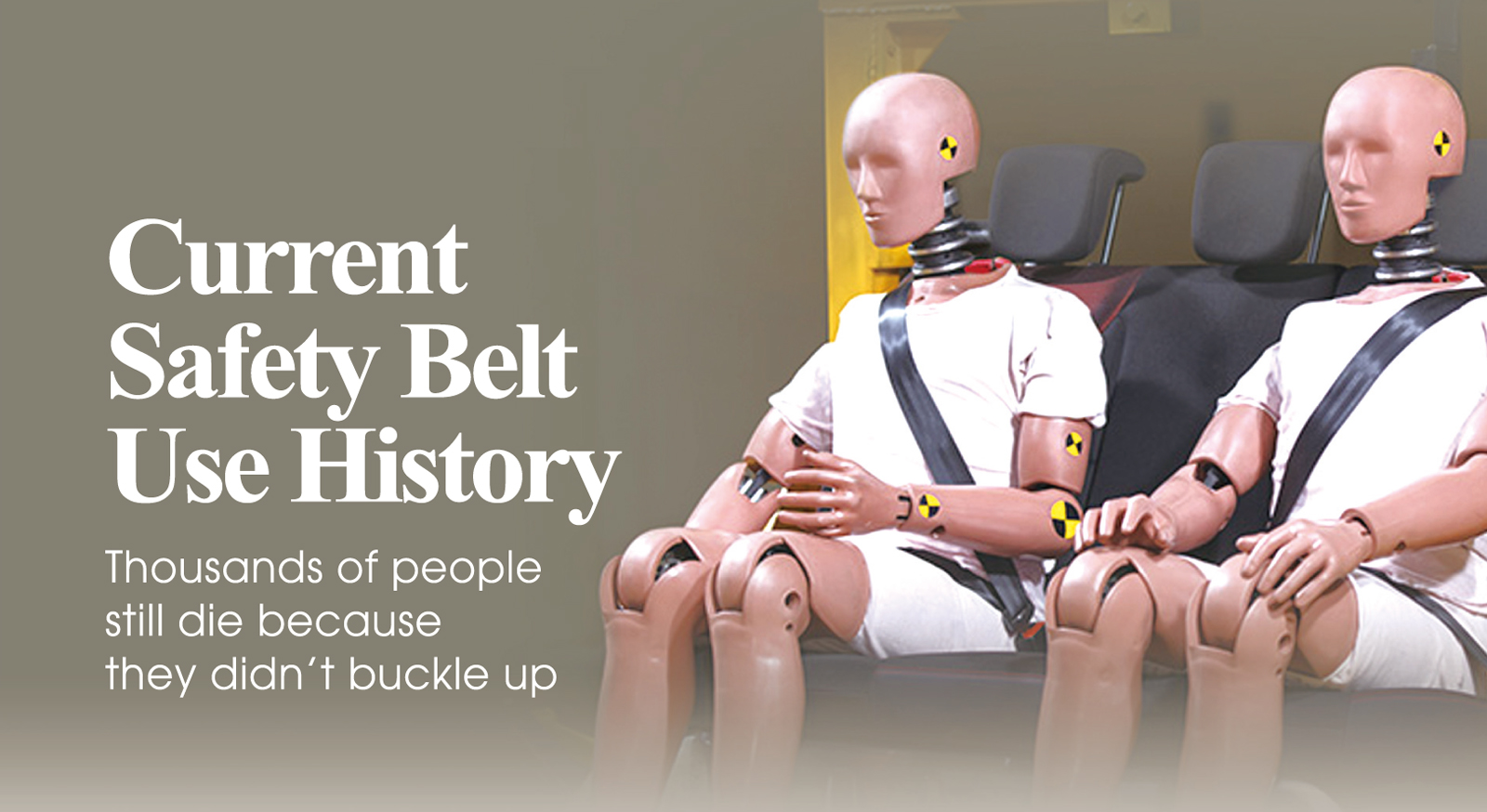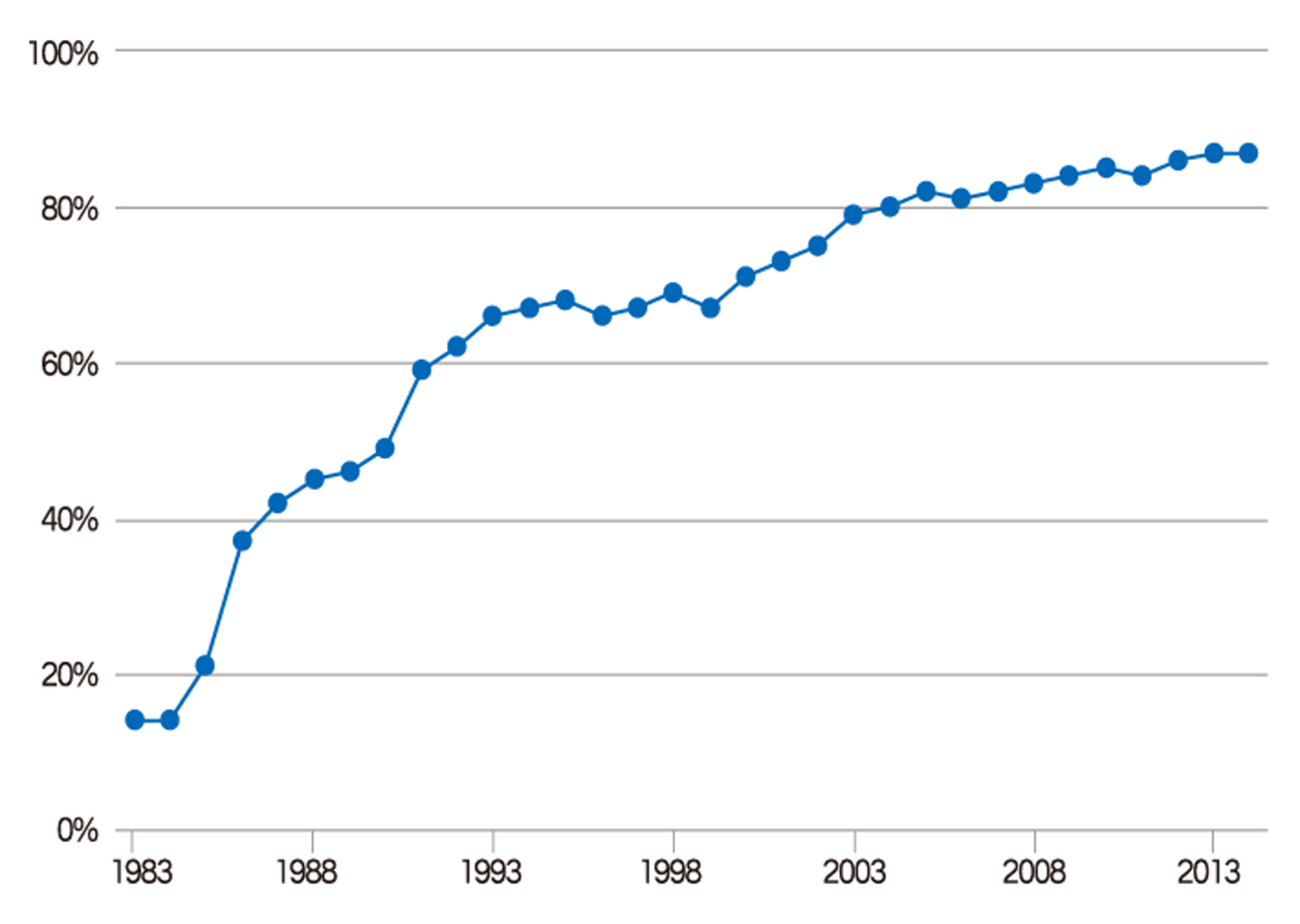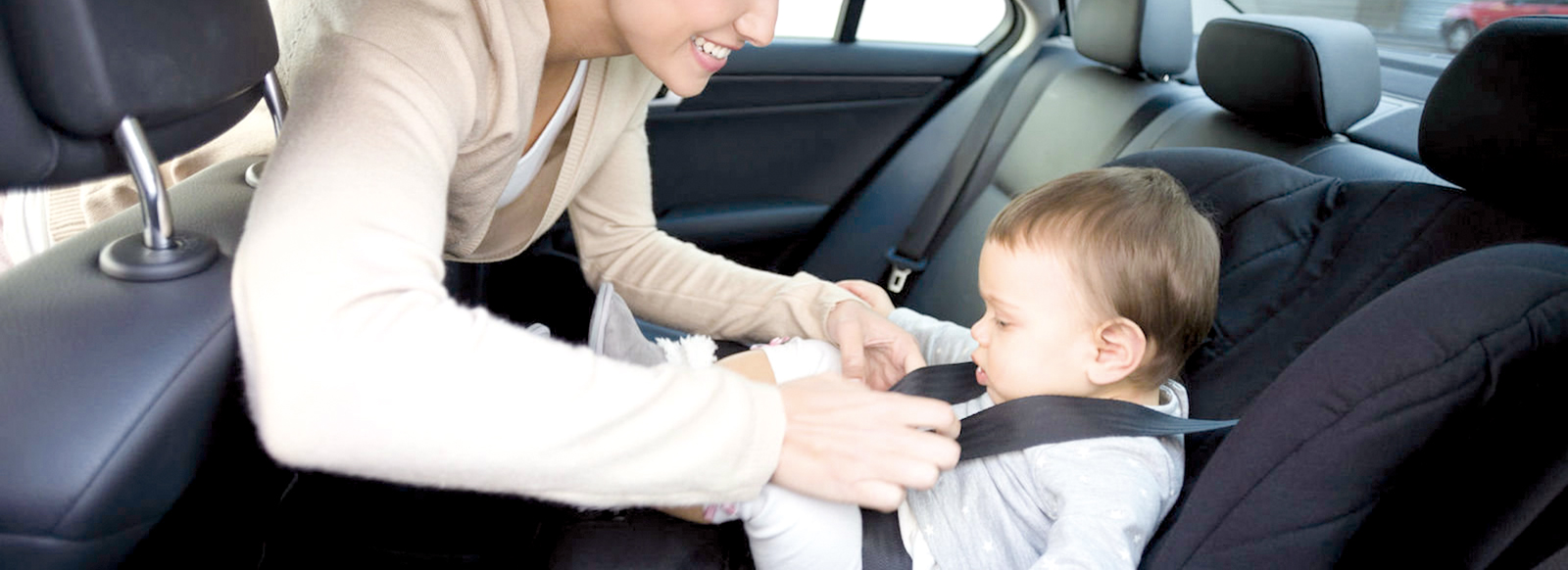
Lap and shoulder belts are designed to keep motorists in their seats during a crash. Without belts, people risk hitting things inside their vehicle and being ejected altogether. Even though their vehicle may have slowed or stopped after colliding with another vehicle or object, unbelted occupants keep moving at the same travel speed until they catch up with and crash into what's in front of them.
Safety belts help to prevent or reduce injuries from this second collision by securing people to their seats so they slow down with the vehicle as its crush zone absorbs most of the kinetic energy associated with the vehicle and the occupant's precrash motion. The longer people "ride down" a crash, the less likely they are to be injured.
Worn properly, safety belts are designed to spread crash forces across the stronger bony parts of the upper body. Safety belts also prevent occupants from being ejected from the vehicle, an event associated with high risk of injury and death. Relative to occupants who are not ejected from vehicles, occupants who are ejected in nonrollover crashes are nearly twice as likely to die, and those who are ejected in rollover crashes are 4 times more likely to die.
Yes. Nationwide observed safety belt use in 2014 was 87 percent for drivers and 85 percent for right front seat passengers. Belt use is lower in the back seat: 78 percent of rear seat occupants were observed using belts in 2013 compared with 87 percent of front seat occupants. In 2014, 19 states and the District of Columbia had use rates of 90 percent or higher. Oregon had the highest belt use rate (98 percent), and South Dakota had the lowest (69 percent).
Fewer than half of passenger vehicle drivers (47 percent) and passengers (43 percent) ages 13 and older killed in 2013 were using belts. Only 27 percent of fatally injured back seat occupants ages 13 and older were using belts. Belt use rates are lower among fatally injured occupants than among the general population because risk of death is much higher when not using a safety belt. Plus, people who don't use belts tend to be riskier drivers.
The 2014 observed belt use rate among front seat occupants was about 6 times the rate observed in 1983 (87 percent vs. 14 percent). The following chart shows the changes in belt use during this time period.

In both the front seat and the back seat, safety belts reduce the risk of serious injury or death in a crash. Research has shown a 45 percent reduction in the risk of a fatal injury to front seat car occupants when lap and shoulder belts are used. The risk of a moderate to critical injury is reduced by half. For people in front seats of SUVs, vans and pickups, the use of lap and shoulder belts reduces the risk of a fatal injury by 60 percent and a moderate to critical injury by 65 percent.
Among back seat outboard occupants in cars, lap and shoulder belts reduce the risk of fatal injury by 44 percent; among back seat outboard occupants of vans and SUVs, the reduction is 73 percent.
The National Highway Traffic Safety Administration (NHTSA) estimates that safety belts saved the lives of 12,584 people in 2013 and and more than 62,000 lives during the five year period from 2009 through 2013. An additional 2,800 lives could have been saved in 2013 if all passenger vehicle occupants older than age 4 had used safety belts.
Yes. In a frontal crash, drivers and front seat passengers are at increased risk of injury from unbelted back seat passengers, and in a side impact crash, passengers sitting adjacent to unbelted passengers are at increased risk of injury. Exposure to unbelted occupants increases the risk of injury or death to other occupants in the vehicle by 40 percent. In a frontal crash, an unbelted rear seat passenger sitting behind a belted driver increases the risk of fatality for the driver by 137 percent compared with a belted rear seat passenger.

No. It took a long time to get safety belts in all new vehicles. Prior to a federal standard, many manufacturers began installing lap belts in front seats in response to state laws requiring safety belts in new cars. It wasn't until 1968 that the federal government required lap and shoulder belts in the front outboard seats of all new cars sold in the United States except convertibles.
In 1973, federal regulators upgraded the safety belt standard to require three point lap and shoulder belts with inertia reels that lock the belt during a rapid deceleration. Lap and shoulder belts were mandated in the outboard rear seats of cars sold in the U.S. starting in model year 1990, and in pickups, passenger vans, and SUVs starting in model year 1992. A requirement for three point belts for inboard rear seating positions was phased in between Sept. 1, 2005, and Sept. 1, 2007.
A lap belt is better protection than no belt in a crash. In a study of potentially fatal crashes involving back seat occupants age 5 and older, lap belts reduced the risk of fatal injury for outboard occupants by 32 percent in cars and 63 percent in vans and SUVs. Although lap only belts weren't as effective as lap and shoulder belts, particularly in frontal crashes, using lap only belts provided more protection than being unrestrained. The addition of a shoulder belt in the center rear reduces the risk of injury by 81 percent among children seated in this position compared with lap only belts. For the best protection, children should ride in the back seat in an appropriate child safety seat or a properly fitted lap and shoulder belt.
For safety belts to do their job, it's important that they fit right. That's why it is so critical for children who have outgrown their forward facing child restraints to use belt positioning boosters.
A properly fitted shoulder belt should lie snugly across the center of the chest and shoulder, not on the neck or face or falling off the shoulder. The lap belt should lie snugly across the upper thighs or low on the hips, not the belly.
When shopping for a new vehicle, try on the safety belts to see whether they are a good fit for you and the other passengers who will be riding in the vehicle. In many vehicles, belts can be customized for a better fit. For example, adjustable D-rings allow shoulder belts to be raised or lowered as needed. Ask your dealer or consult the vehicle manual for more information. If your safety belt is not long enough, it may be possible to lengthen it with a belt extender from your vehicle manufacturer.
Any restraint is better than none at all, but a properly fitting belt offers the best protection.

With the exception of New Hampshire, all states and the District of Columbia require adult front seat occupants to use safety belts. Adult rear seat passengers also are covered by the laws in 28 states and the District of Columbia.
Yes, but some types of laws are more effective than others. An important consideration is whether a belt use law allows primary enforcement. Primary, or standard, enforcement laws allow a police officer to stop and cite a motorist solely for not using a safety belt. In states with secondary enforcement, police can only enforce the law if the motorist has been pulled over for another violation first.
Legislators in some states were reluctant to enact primary laws because of concerns that police would use the safety belt law to harass minorities. However, several studies found that changing from secondary to primary enforcement resulted in proportionally equal or fewer tickets for minorities.
Today, 34 states and the District of Columbia have primary laws, while 16 states have secondary safety belt laws.
In 2014, observed front seat occupant belt use rates were 11 percentage points higher in states with primary enforcement than in other states (90 vs. 79 percent). Based on drivers' self reports, the frequency of never using a safety belt was twice as high in states with secondary enforcement compared with states with primary enforcement laws. States that went from secondary to primary enforcement laws saw a 14-percentage point median increase in observed belt use.
In states that require belt use in all seating positions, 83 percent of back seat passengers were observed using safety belts in 2013, compared with 74 percent of back seat passengers in states that require only front seat belt use.
Higher fines for safety belt violations also are associated with higher rates of observed belt use and higher rates of belt use among fatally injured front seat occupants. An increase in fines from $25 to $60 was associated with 3-4 percentage point increases in belt use, while increasing fines from $25 to $100 was associated with 6-7 percentage point increases.
Numerous studies show that publicized enforcement campaigns such as "Click It or Ticket" are needed to sustain high levels of compliance over time. In 1993, North Carolina implemented the first statewide "Click It or Ticket" campaign. Institute research found that driver belt use increased from 64 percent before the campaign to 80 percent after the first three week enforcement period.
The first nationwide "Click It or Ticket" campaign was held in May 2003. An evaluation of the 2007 campaign found that belt use increased in 38 states, the District of Columbia and Puerto Rico. Increases were seen in states with and without primary laws.
Yes. Systematic literature reviews show that both primary and secondary laws reduce deaths and nonfatal injuries, but primary laws have the greater effect. The incremental effect of primary versus secondary laws on fatalities is estimated at 3-14 percent.
Institute research has shown that switching from a secondary law to a primary law reduces passenger vehicle driver deaths by 7 percent. Based on this research, if all states that still had secondary laws in 2012 had switched to primary laws, 265 lives could have been saved that year.
Safety belt use is lower among younger people and males. In 2013, 83 percent of 16-24 year-olds in the front seat were observed using their belts compared with 88 percent of those 25-69 years old and 88 percent of those 70 and older. Eighty-nine percent of female front seat occupants were observed using their belts compared with 85 percent of males.
Observed belt use in 2014 was lowest among occupants of pickups (77 percent), compared with occupants of vans and SUVs (89 percent) and cars (88 percent). Belt use also is lower in the back seat. In 2013, 78 percent of rear seat occupants were observed using belts compared with 87 percent of front seat occupants.
Research also shows that belt use is lower among occupants of older vehicles and among drivers who have been drinking alcohol. In an analysis of 10 years of data on belt use among fatally injured occupants, use was consistently about 18 percentage points lower at night than during the day.
Nighttime unbelted drivers have more previous traffic violations and criminal arrests than nighttime belted drivers and daytime drivers belted or unbelted.
A national telephone survey conducted by the Institute in 2012 found the top reasons for not using safety belts among people who used belts some but not all of the time included driving a short distance, forgetfulness, and discomfort. Among people who never used safety belts, the top reasons for not using them were discomfort, the belief that it's not necessary, and a dislike of being told what to do. These findings are consistent with earlier national studies.
In another national survey in 2007, about one-third of all drivers thought safety belts were just as likely to harm as to help, and perceived harm was greater among less frequent belt users. The youngest drivers (ages 16-20) were most likely to think that belts were potentially harmful.

Not all safety belt reminders are effective in raising belt use. Federal safety standards require a belt reminder system for drivers that provides a warning light and an audible warning lasting 4-8 seconds. However, auditory reminders lasting 8 seconds or less have not been found to be effective at increasing safety belt use. In contrast, enhanced belt reminders (auditory reminders that last longer than 8 seconds) increase belt use among drivers and front seat passengers.
NHTSA observed safety belt use among occupants of vehicles with and without enhanced belt reminders and found that the enhanced reminders increased seat belt use by 3-4 percentage points. A 2010 Institute study found that driver fatality rates were 6 percent lower in vehicles with enhanced safety belt reminders compared with vehicles without them.
Most vehicle manufacturers equip their vehicles with enhanced safety belt reminder systems. Of 2014 models sold in the United States, 90 percent came with enhanced safety belt reminder systems for the driver as standard equipment, while 73 percent had enhanced reminder systems for right front passengers.
Belt reminders that last longer are encouraged in Europe through the European New Car Assessment Programme (EuroNCAP) and have been shown to increase belt use. Only about 16 percent of 2014 models sold in the U.S. have driver belt reminders that meet EuroNCAP requirements.
In a 2012 Institute telephone survey, more than two-thirds of part time belt users and at least one-third of non-users said they would be more likely to buckle up in response to enhanced belt reminders that become more intense or continue indefinitely. These reminders would be acceptable to about half of part time belt users and about one-fifth of non-users.
No. Federal safety standards do not currently require belt reminders in the back seat. However, in 2012 Congress instructed NHTSA to begin rulemaking to require them.
In the U.S. market, Volvo was the first manufacturer to alert the driver when back seat passengers didn't buckle up. Of vehicle models sold in the United States, only 3 percent of 2014 models had reminder systems that detected safety belt use for back seat passengers.
In a 2012 Institute survey, more than three-quarters of drivers supported belt reminders that would alert them when children in back seats aren’t buckled.
No. NHTSA is prohibited by Congress from requiring safety belt ignition interlocks which prevent a driver from starting the vehicle if the driver is unbelted. In 1973, NHTSA required that all new vehicles not providing passive restraints (e.g., airbags) be equipped with safety belt ignition interlocks. These proved so unpopular that Congress prohibited NHTSA from requiring them.
However, in 2012, Congress removed some of the restrictions on the belt use technologies that NHTSA can require. The agency now can require auditory belt reminders that last longer than 8 seconds and can allow a manufacturer to meet a safety standard by installing belt interlocks.
A recent national telephone survey found that 70 percent of part time belt users and 44 percent of non-users said that they would be more likely to buckle up with ignition interlocks. However, only 30 percent of part time belt users and 16 percent of non-users thought ignition interlocks to increase safety belt use would be acceptable in their vehicles.
Other types of interlocks have been developed but aren't widely available. Gearshift interlocks prevent or delay the vehicle from being put in gear if the driver isn't buckled up, while entertainment interlocks disable the radio or entertainment system.
A pilot study of commercial fleet drivers evaluated a safety belt reminder chime combined with a delay of 8 seconds before an unbelted driver could place the vehicle in gear. The study found the system increased safety belt use by about 20 percentage points.
In the U.S. market, General Motors is the first manufacturer to offer a gearshift interlock. It is available on certain 2015 fleet vehicles. This feature prevents the driver from placing the vehicle in gear unless the driver and, if present, front seat passenger are buckled.
Another technology involves tactile feedback. In a pilot test with a small sample of commercial drivers, unbelted drivers who drove faster than 25 mph experienced resistance of the accelerator pedal. Drivers could continue to drive faster than 25 mph without buckling up, but the pedal resistance continued until they fastened belts. The effect was an immediate increase in safety belt use to 100 percent, and the drivers found the system acceptable.
Many newer vehicles are equipped with safety belt pretensioners that tighten up slack in the belt when triggered by vehicle sensors. The pretensioner tightens the belt almost instantaneously in the event of a crash.
The industry's first inflatable belts, developed by Ford to better protect rear seat occupants, were first available on certain 2011 Explorers. Inflatable safety belts aim to reduce head, neck and chest injuries by deploying over the occupant's torso and shoulder during a crash so that crash forces are distributed to an area of the body 5 times larger than with conventional safety belts. When vehicle sensors determine that a severe collision is occurring, the belt's airbag fills with cold compressed gas and expands sideways across the occupant's body. The inflatable belt should operate like a conventional safety belt for everyday use.
